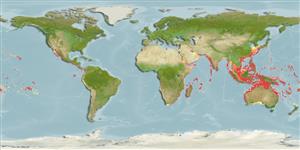Common names from other countries
Environment: milieu / climate zone / depth range / distribution range
Ökologie
seewasser riff-verbunden; tiefenbereich 1 - 100 m (Ref. 48635). Tropical; 35°N - 37°S
Indo-Pacific: Red Sea and East Africa to the Hawaiian, Marquesan and Tuamoto islands, north to southern Japan and the Ogasawara Islands, south to Australia and New Zealand.
Size / Gewicht / Alter
Maturity: Lm ? range ? - ? cm
Max length : 40.0 cm TL Männchen/unbestimmt; (Ref. 3392); common length : 20.0 cm TL Männchen/unbestimmt; (Ref. 3392)
Rückenflossenstacheln (insgesamt) : 7; Rückenflossenweichstrahlen (insgesamt) : 9; Afterflossenstacheln: 0; Afterflossenweichstrahlen: 6 - 7. Heavily armored box-like body and wing-like pectoral fins (Ref. 37816).
Inhabit coastal waters with sandy substrates (Ref. 1602, 48635); a shallow-living species, benthic in adults; only species found in oceanic islands (Ref. 27821). Solitary, well-camouflaged and slow-moving (Ref. 37816, 48635). Feed on crustaceans, clams, and small fish. May be caught using ring nets (Ref. 5213).
Life cycle and mating behavior
Maturities | Fortpflanzung | Spawnings | Egg(s) | Fecundities | Larven
Paxton, J.R., D.F. Hoese, G.R. Allen and J.E. Hanley, 1989. Pisces. Petromyzontidae to Carangidae. Zoological Catalogue of Australia, Vol. 7. Australian Government Publishing Service, Canberra, 665 p. (Ref. 7300)
IUCN Rote Liste Status (Ref. 130435)
CITES (Ref. 128078)
Not Evaluated
Bedrohung für Menschen
Harmless
Nutzung durch Menschen
Fischereien: weniger kommerziell; Aquarium: Kommerziell
Tools
Zusatzinformationen
Download XML
Internet Quellen
Estimates based on models
Preferred temperature (Ref.
115969): 23.3 - 29, mean 27.8 (based on 1738 cells).
Phylogenetic diversity index (Ref.
82804): PD
50 = 0.5234 [Uniqueness, from 0.5 = low to 2.0 = high].
Bayesian length-weight: a=0.00389 (0.00180 - 0.00842), b=3.12 (2.94 - 3.30), in cm Total Length, based on all LWR estimates for this body shape (Ref.
93245).
Trophic level (Ref.
69278): 3.7 ±0.55 se; based on food items.
Widerstandsfähigkeit (Ref.
120179): hoch, Verdopplung der Population dauert weniger als 15 Monate. (Preliminary K or Fecundity.).
Fishing Vulnerability (Ref.
59153): Low vulnerability (18 of 100).
